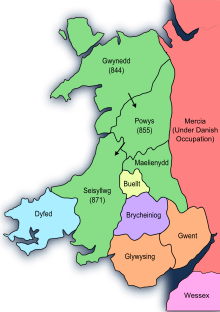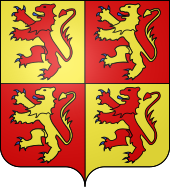Anarawd ap Rhodri
Anarawd ap Rhodri (* approx. 857, † 916 ) was a king of the historic Celtic Kingdom of Gwynedd in northwest Wales , who ruled there as the successor of his father, Rhodris the Great from 878 to 916, successfully defended his country against the Danes and Anglo-Saxons therefore in the Annales Cambriae even referred to as "King of the British ". He was the progenitor of the so-called Aberffraw dynasty, the oldest branch of the descendants of Rhodri the Great.
origin
origin
Anarawd ap Rhodri comes from a very old Celtic ruling family, which according to tradition can be traced back to the historically verifiable Caswallon (for the Romans: Cassivellaunus ), which was built around the time between 60 and 48 BC. Lived at the time of the Roman invasion of Britain in 54 BC. As the high king of the British, he headed the resistance against the second campaign in Britain by Julius Caesar .
His descendants ruled the kingdom of Gwynedd for around four hundred years after the Roman legions withdrew in 410.
Closer ancestors
Closer direct ancestors of Anarawd ap Rhodri in the male line included:
- Coel Hen (Coel the Old), who was ruler in northern Britain after the departure of the Romans around 410-430 and had to defend himself against attacks by the Picts and the Irish .
- Gwriad King of the Isle of Man (cl. C. 800), remembered by the "Crux Guriad" (Cross of Gwriad) in Maughold on the Isle of Man. He was married to Esyllt ferch Cynan (Esyllt, daughter of Cynan) Princess of Gwynedd , a daughter of Cynan Dindaethwy ap Rhodri, King of Gwynedd (798-816), from which later the claim of his son, Merfyn Frych ap Gwriad († 844) ), based on this kingdom.
parents
The father of Anarawd ap Rhodri was Rhodri the Great ( Welsh Rhodri Mawr ), also called Rhodri ap Merfyn Frych (Rhodri, son of Merfyn the Freckled) (* approx. 820; † 878). In 844, after the death of his father, he became King of Gwynedd (844 to 878) through the death of his maternal uncle in 854, King of Powys (854 to 878) and through the death of his brother-in-law in 871, King of Seisyllwg (855 to 878) and thereby became ruler much of Wales. This and the successful defense against attacks by the Anglo-Saxons and the Vikings earned him the honorary title of "the great" as the first Welsh ruler.
The mother of Anarawd ap Rhodri was Angharad ferch Meurig (* approx. 825 in Ceredigion Wales, a daughter of King Meurig ap Dyfnwallon, King of Seisyllwg (cl. Approx. 850)) and sister of Gwgon ap Meurig, the last king of Seisyllwg her house, which drowned in 871 under circumstances that were not entirely clear, whereby the Seisyllwg kingdom fell to her husband, Rhodri the Great.
Life
King of Gwynedd
According to tradition, Anarawd ap Rhodri was born around 857 in the old (later completely rebuilt) castle Caernarfon ( Welsh : Caer Seiont), Caernarvonshire in North West Wales, the eldest son of his father. He had made himself the ruler of the greater part of Wales, but after his death this large area of rule was divided up among his sons, with the result that the unity of all of Wales was again moved into the far distance.
After the death of King Rhodri the Great in 878, Anarawd followed as the eldest son as King of Gwynedd (878-916), while his younger brothers Cadell ap Rhodri as King of Seisyllwg (878-909) and Merfyn ap Rhodri as King of Powys (878–900) followed her father. Together, the brothers sought to expand their rule at the expense of the remaining smaller Welsh kingdoms. Cadell ap Rhodri succeeded in conquering the neighboring kingdom of Dyfed (now the " Preserved County " Dyfed) , which is located in the south-western part of Wales .
Defense against Mercia
For generations, military conflicts have been fought with the neighboring Anglo-Saxon Kingdom of Mercia in the east, which are still remembered today by the impressive remains of the fortifications near the border, such as Offa's Dyke , built around 800 , that of King Offa of Mercien along the border with the Welsh kingdoms of Gwynedd and Powys was built. Last but not least, this conflict had also cost King Anarawd's father, Rhodri the Great, his life. Relations with Mercia remained problematic. King Æthelred of Mercia (883–911), King Alfred of Wessex had to submit, therefore only bore the title " Ealdorman ", later Earl of Mercia . However, this did not prevent him from undertaking several military expeditions to Wales. As early as 881 he made an advance to Gwynedd, which was however repulsed by Anarawd, who defeated Æthelred in a bloody battle at the mouth of the River Conwy (Welsh Afon Conwy) in the Irish Sea . This success was celebrated in the Welsh annals as God's retribution for killing Rhodris.
Defense against the Danes
In order to protect himself against further attacks, Anarawd allied himself around the year 884 with the Danes, who had recently founded the Kingdom of Jórvík (center was the later city of York ) under King Gothfrith (883-895) . However, this alliance proved to be unsustainable, as shortly afterwards the Danes attacked Gwynedd from East Anglia in 894, Anarawd found it difficult to repel them and King Gothfrith I died on August 24, 895.
Alliance with King Alfred
Hence, King Anarawd turned to King Alfred the Great 871 King of Wessex , then king of the Anglo-Saxons (886-899), who was not only the overlord of threatening the kingdom of Mercia, but also the most powerful Anglo-Saxon king, therefore most likely also the Danes , the Could offer forehead. He therefore visited King Alfred at his court, who kindly promised him his protection. However, this under the two conditions: that Anarawd, who belonged to the Celtic Church , would be baptized again according to the Roman rite (although the “Celtic” practice did not differ very much from the Roman) and that he was also under the rule of King Alfred subjugated. Obviously, King Anarawd had no choice, which is why he agreed to these harsh terms. This was the first time a Welsh king - who had fought for centuries for independence and sovereignty - recognized the suzerainty of an Anglo-Saxon king. From this point was therefore expected that the kings of Gwynedd the kings of England , the homage afford.
Attack on Welsh neighbors
This alliance apparently boosted Anarawd's military confidence, as he soon found himself able to take the offensive himself. As early as 895 he made a foray into the neighboring Welsh Kingdom of Seisyllwg in south Wales and plundered the provinces of Ceredigion and Ystrad Tywi there.
Last successes and death
In 902 there was another attack by a Danish fleet under the leadership of King Ingimund of Dublin on the island of Anglesey (Welsh: Ynys Môn) Anarawd succeeded in repelling this attack and forcing the Danes to withdraw. An indication that his influence in the view of posterity was not limited to his own small kingdom, and this was seen at least in Wales as supra-regional, can be found in the Annales Cambriae in which he was referred to as "King of the British". Anarawd died in 916, leaving his son Idwal Foel (Idwal the Bald) a strong kingdom of Gwynedd.
Ancestor of the Aberffraw family
Anarawd ap Rhodri became the progenitor of the royal house, which was referred to as the "House of Aberffraw", which name is derived from the historic capital of his kingdom, Aberffraw on the island of Anglesey (on the southwest coast of the island, on the bank of the Afon Ffraw river) . Aberffraw is now just a village, where around 80% of the population still uses Welsh as their main language. The Aberffraw dynasty ruled over Gwynedd for almost four hundred years, which only fell with the conquest of Wales by King Edward I , who himself assumed the title of Prince of Wales in 1283 and incorporated the entire principality into the Kingdom of England in 1284 with the Statute of Rhuddlan . According to the annals of King Edward I of England, the old castle (Ilys) of the kings of Gwynedd was demolished on his behalf and used as building material for the fortress he built nearby to secure the submission of the Welsh, Beaumaris Castle .
Marriage and offspring
Neither the name nor the origin of the wife of King Anarawd of Gwynedd are known.
Children:
- Idwal Foel ap Anarawd (Idwal the Bald, son of Anarawd) King of Gwynedd (916–942)
- Elisedd ap Anarawd (* approx. 885; † 942)
Individual evidence
- ↑ Mike Ashley: op cit. Chart 1 Celts (1) - Early Britain, p. 67
- ↑ Mike Ashley: op cit. Pp. 67, 96 and 97
- ^ Gwynfor Evans: Land of my fathers: 2000 years of Welsh history, Barnes & Noble (1993)
- ↑ Mike Ashley, op. Cit.S. 422
- ↑ Mike Ashley "The Mammoth Book of British Kings and Queens"; Constable Publishers, London, reprinted 2000; ISBN 1-84119-096-9 , p. 346
- ↑ Mike Ashley "The Mammoth Book of British Kings and Queens"; Constable Publishers, London, reprinted 2000; ISBN 1-84119-096-9 , p. 347
- ↑ Mike Ashley: op. Cit. P. 460
literature
- John Edward Lloyd: A history of Wales from the earliest times to the Edwardian conquest (Longmans, Green & Co.) (1911)
- Davies, John (1990), A History of Wales (First ed.), London: Penguin Group (published 1993), ISBN 0-7139-9098-8
- Mike Ashley: “The Mammoth Book of British Kings and Queens”, Carroll & Graf Publishers, Inc. New York, 1998 151
- Phillimore, Egerton (1888), "The Annales Cambriae and Old Welsh Genealogies, from Harleian MS. 3859", in Phillimore, Egerton, Y Cymmrodor, IX, Honorable Society of Cymmrodorion, pp. 141 - 183,
Web links
- Rhodri the Great (in English)
- Rhodri Mawr - King of Wales (About Dinefwr Castle in Carmathenshire, believed to have been built by Rhodri - in English)
| predecessor | Office | successor |
|---|---|---|
| Rhodri the Great |
King of Gwynedd 878-916 |
Idwal Foel (Idwal the Bald) ap Rhodri |
| personal data | |
|---|---|
| SURNAME | Anarawd ap Rhodri |
| ALTERNATIVE NAMES | Anarawd ap Rhodri Mawr |
| BRIEF DESCRIPTION | King of Gwynedd (Wales) |
| DATE OF BIRTH | 9th century |
| DATE OF DEATH | 916 |


